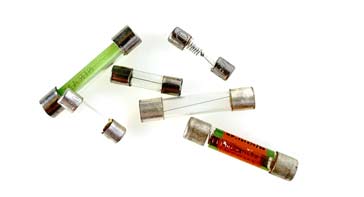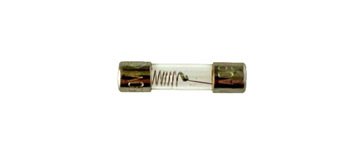An In-Depth Look at Electrical Fuses
Electrical Fuses are an age-old method of providing the last ditch safety to all forms of electrical and electronic equipment.
Home » Electronic components » this page
Electrical fuses includes:
Fuses 101
Electrical fuses may seem a rather crude method for protecting electrical and electronic equipment - they simply consist of a single wire that blows when the current exceeds a certain value.
However, electrical fuses have been used for many years, and they are still used as a last ditch method of preventing major damage to electrical equipment and the power source.
These simple fuses have saved many pieces of equipment from further damage as well as preventing electrical faults from becoming major fires.
As such electrical fuses are essential in providing protection and safety, even in these days if highly integrated electronics.

Fundamental fuse principle
At its core, an electrical fuse is a deliberately weakened link in an electrical circuit. Its primary function is to protect the circuit and its components from excessive current.
The basic principle behind the electrical fuse is very simple and straightforward and it has been used for many years, and it is likely to remain widely used for many years to come.
The fuses all use the same principle and have the same basic construction. Every fuse contains a metallic element, typically a wire or strip, with a specific melting point and electrical resistance.
When the current flowing through the circuit exceeds a predetermined safe level (the fuse's rated current), the metallic element heats up due to the increased electrical resistance.

Probably the most widely used circuit symbol for a fuse
If the overcurrent persists, the element reaches its melting point, melts, and creates an open circuit. This breaks the flow of electricity, effectively isolating the faulty section and preventing damage to upstream or downstream components, or, more importantly, averting a potential fire.
The speed at which a fuse blows is not always instantaneous, and this is a crucial characteristic. Fuses exhibit an "inverse time-current characteristic."
This means that the greater the overcurrent, the faster the fuse will melt and open the circuit. Conversely, a slight overload might take minutes or even hours to blow a fuse, whereas a direct short circuit will cause it to blow almost instantaneously, often in milliseconds.
This nuanced behavior allows fuses to differentiate between transient, harmless surges (like those from a motor starting) and sustained, dangerous overloads.
Video: Watch a Fuse Blow: what happens
The Evolution of Fuse Technology
While the concept of a sacrificial link seems straightforward, the practical application and refinement of fuse technology have evolved significantly since their earliest forms.
The earliest fuses were often just thin wires inserted into circuits. However, with the advent of electrical distribution, the need for standardised, reliable protection became paramount.
One of the earliest and most influential figures in fuse development was Thomas Edison. Recognizing the danger of electrical fires, he patented his "Safety Conductor" in 1890, which was essentially a thin wire designed to melt and protect his incandescent lighting systems.
This early innovation laid the groundwork for the modern fuse.
Over the decades, materials science and engineering advancements have led to a diverse range of fuse types, each optimized for specific applications and performance characteristics.
From the simple wire in a ceramic body to sophisticated current-limiting devices, the evolution of fuses mirrors the increasing complexity and demands of electrical systems.
Fuses types and characteristics
There are very many different types of fuse, with each type designed to meet specific protection requirements.
Understanding these different types is key to appreciating their critical role.
Cartridge Fuses: These are perhaps the most common type, consisting of a cylindrical body (often ceramic or glass) with metal end caps that serve as contacts. Inside, the fuse element is encased, sometimes in a sand-filled body to help quench the arc that forms when the fuse blows, especially at higher voltages.
Glass Cartridge Fuses (e.g., AGC, AGW): Typically found in lower voltage DC applications (like automotive circuits) and some electronics. Their transparent body allows for visual inspection of the fuse element. They are generally fast-acting.
Ceramic Cartridge Fuses (e.g., ABC, MDL): Offer higher breaking capacities and are often used in AC circuits, appliances, and industrial applications. The ceramic body provides better thermal and arc-quenching properties.
Blade Fuses or Automotive Fuses: These are characterized by their plastic bodies and two prongs (blades) that plug into a fuse holder. They are color-coded by amperage for easy identification and are ubiquitous in automotive electrical systems. Common types include ATO, Mini, Maxi, and Low-Profile Mini, each designed for different current ratings and space constraints.
Resettable Fuses (Polymeric Positive Temperature Coefficient - PPTC devices or Polyswitches): Unlike traditional fuses, which are single-use, PPTC devices are self-resetting. They are made from a conductive polymer that dramatically increases in resistance when heated by an overcurrent. This increased resistance limits the current flow to a safe level. Once the fault is removed and the device cools, its resistance drops, and it "resets" to its low-resistance state, allowing current to flow again. They are commonly found in USB ports, computer power supplies, and other consumer electronics where nuisance fuse blows would be inconvenient.
High Rupturing Capacity (HRC) Fuses: Also known as High Breaking Capacity (HBC) fuses, these are designed to safely interrupt very large short-circuit currents without exploding or sustaining damage. They are typically filled with an arc-quenching material like quartz sand and have robust ceramic bodies. HRC fuses are essential in industrial settings, main distribution boards, and applications where the available fault current can be extremely high. They come in various industrial standards (e.g., BS, DIN, UL).
Rewireable Fuses (Semi-Enclosed Fuses): Though becoming less common due to safety concerns and the prevalence of circuit breakers, these fuses allow the fuse element to be replaced by the user. They consist of a fuse carrier that holds a replaceable fuse wire. While economical, there's a risk of using incorrect wire gauges, potentially compromising safety. They are still found in some older domestic and light industrial installations.
Surface Mount Device (SMD) Fuses: Tiny fuses designed for mounting directly onto printed circuit boards (PCBs) in compact electronic devices. They are essential for protecting sensitive components in smartphones, laptops, and other miniaturized electronics.
Key fuse characteristics and terminology
There is a number of terms and terminology associated with fuses and their use. It is important to understand what they mean before designing a fuse into a circuit to ensure the correct performance and the best protection.
Rated Current (Amperage Rating): This is the maximum current the fuse is designed to carry continuously without blowing. It's usually marked in Amperes (A) on the fuse body.
Voltage Rating: This indicates the maximum voltage the fuse can safely interrupt. It's crucial that the fuse's voltage rating meets or exceeds the circuit voltage. A fuse with a lower voltage rating might fail to properly extinguish the arc when it blows, leading to a dangerous condition.
Breaking Capacity (Interrupting Rating / Rupturing Capacity): This is perhaps the most critical safety characteristic. It specifies the maximum prospective fault current that the fuse can safely interrupt without being destroyed or causing damage outside its enclosure. This is often expressed in kiloamperes (kA). It's vital that the fuse's breaking capacity exceeds the maximum possible short-circuit current that could occur at its point of installation.
Time-Current Characteristic (Speed of Operation): This defines how quickly the fuse will blow at different levels of overcurrent. There are two types of fuse that are commonly seen:
- Fast-Acting Fuses: Blow very quickly on even slight overloads. Ideal for protecting sensitive electronic components that cannot tolerate even momentary overcurrents.
- Slow-Blow / Time-Delay Fuses: Designed to withstand temporary current surges (inrush currents) without blowing. They have an intentional delay built into their design (often via a larger or spring-loaded element). Perfect for circuits with motors, transformers, or other inductive loads that have high momentary startup currents.
I²t Value: This often overlooked but important characteristic represents the energy required to melt the fuse element. It's used for coordination studies, ensuring that upstream and downstream protection devices trip in the correct sequence.
Mounting Type: Refers to how the fuse is installed (e.g., panel mount, PCB mount, blade, bolt-on).

Note the coiled wire to remove heat and the soldered joint to blow when persistent current is applied.
How fuses blow
Fuses are designed to protect circuits from overcurrents, but they don't typically blow exactly at their rated current.
It is very useful to have an understanding of how they blow.
Continuous Current: A fuse is designed to carry its rated current indefinitely without blowing. In fact, many fuses can carry significantly more than their rated current for extended periods without blowing. For example, a 13A fuse might allow 20A to pass indefinitely. It's often recommended not to exceed 75-80% of a fuse's rated value for continuous current to avoid nuisance blows or fatigue.
Non-Fusing Current: There's a specified "non-fusing current" which is the maximum current a fuse can carry for a certain amount of time (e.g., 30 minutes) without blowing. For some standards (like BS 1362 for UK plug fuses), this can be 1.6 times the rated current. So, a 13A fuse might withstand 20.8A for 30 minutes.
Fusing Current: This is the current at which the fuse must blow within a specified time (e.g., 30 minutes). For BS 1362 fuses, this is often 1.9 times the rated current. So, a 13A fuse would be expected to blow within 30 minutes if the current exceeds 24.7A.
Inverse Time-Current Characteristic: The key principle is that fuses have an "inverse time-current characteristic." This means the greater the current is above the rated current, the faster the fuse will blow.
- Slight Overload (e.g., 110-150% of rated current): At currents just slightly above their rating, fuses can take a very long time to blow—minutes, hours, or even days. This is because they need to generate enough heat to melt the fuse element, and at lower overcurrents, heat dissipates more easily.
- Significant Overload (e.g., 200% or more of rated current): As the current increases significantly (e.g., double the rated current), the fuse will blow much faster, typically within seconds or even milliseconds.
Applications of fuses
Fuses are a standard form of protection device. They are cheap, simple and easy to use. They provide a very reliable form of last ditch protection for any electrical or electronic item.
Fuses are used across a vast number of different areas - everything fro domestic to large industrial plants.
Looking more specifically there are several more specific examples with additional details given below;
Residential Wiring: In older homes, rewireable or cartridge fuses were common for circuit protection. While largely superseded by Miniature Circuit Breakers (MCBs) in modern installations, fuses still play a role in appliances and older sub-circuits.
Appliance Protection: Almost every electrical appliance, from televisions and microwaves to washing machines and refrigerators, contains one or more internal fuses to protect its internal circuitry from faults.
Automotive Industry: Blade fuses are fundamental to the safety and reliability of vehicle electrical systems, protecting everything from headlights and radios to engine control units.
Industrial Control Systems: HRC fuses are extensively used in motor control centers, switchgear, and power distribution panels to protect heavy machinery, motors, and industrial equipment from fault currents.
Electronics and IT: SMD fuses protect sensitive integrated circuits and microprocessors in computers, smartphones, tablets, and a vast array of consumer electronics. PPTC devices are common in USB ports and other low-power applications.
Telecommunications: Fuses protect delicate communication equipment from lightning strikes and power surges.
Renewable Energy Systems: Fuses are critical in solar panel installations and wind turbines to protect against short circuits and overcurrents.
Fuse Selection
It may be thought that the selection of a fuse is very simple. Well, it is and it isn't - there are several considerations when making a selection of the type and rating for a fuse for a particular circuit, situation, etc.
Normal Operating Current: The rated current of the fuse should be slightly higher than the circuit normal operating current.If the rating is too high then it might not trip when there is a fault condition, and too low and there might be times when it blows when there is no fault.
A general rule of thumb is to select a fuse that is about 150% to 200% of the continuous operating current, but be aware that running close to the maximum limit can cause occasional failures.
Voltage: The fuse's voltage rating must be equal to or greater than the maximum circuit voltage.
Breaking Capacity: This is paramount. The fuse's breaking capacity must be higher than the maximum possible fault current that the power source can deliver at the point of installation. Failure to adhere to this can lead to catastrophic failure of the fuse itself during a short circuit.
Time-Current Characteristic: The fuse's speed of operation (fast-acting, slow-blow) must match the requirements of the load it is protecting. For example, a slow-blow fuse is needed for motor circuits to allow for inrush current, while a fast-acting fuse is best for sensitive electronic components.
Ambient Temperature: Fuse ratings are typically given for a standard ambient temperature (e.g., 25°C). In higher temperature environments, a de-rating factor may need to be applied as higher temperatures reduce the current-carrying capacity of the fuse element.
Standards and Approvals: Fuses must comply with relevant national and international standards (e.g., IEC, UL, BS) to ensure their safety and performance.
Standards and regulations
Fuses are so widely used and so critical in all forms of electrical and electronic equipment that they need to be totally relied upon. To ensure that their reliability and safety can be guaranteed, their specifications and regulations are underpinned by rigorous national and international standards.
Organizations like the International Electrotechnical Commission (IEC) and Underwriters Laboratories (UL) develop specifications for fuse construction, testing, and performance.
These standards ensure that fuses manufactured by different companies perform predictably and reliably under fault conditions. For instance, in the UK, BS 1362 specifies the characteristics of plug fuses, ensuring consistency and safety for domestic appliances.
These standards define everything from breaking capacity and time-current characteristics to physical dimensions and marking requirements, all contributing to a safer electrical environment.
 Written by Ian Poole .
Written by Ian Poole .
Experienced electronics engineer and author.
More Electronic Components:
Batteries
Capacitors
Connectors
ADC
DAC
Diodes
FET
Inductors
Memory types
Phototransistor
Quartz crystals
Relays
Resistors
RF connectors
Switches
Surface mount technology
Thyristor
Transformers
Transistor
Unijunction
Valves / Tubes
Return to Components menu . . .



